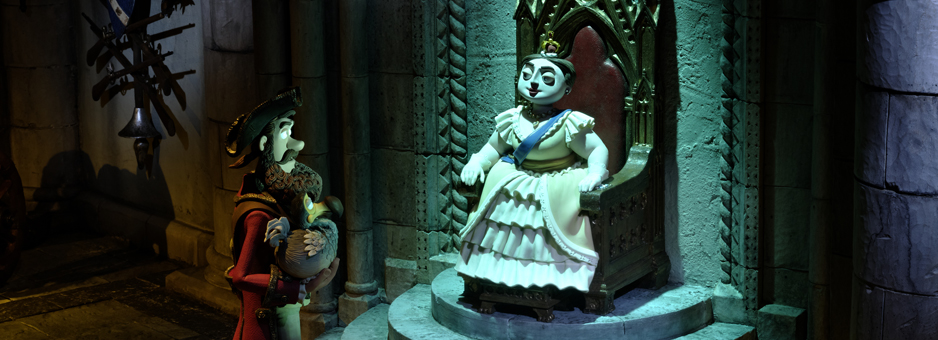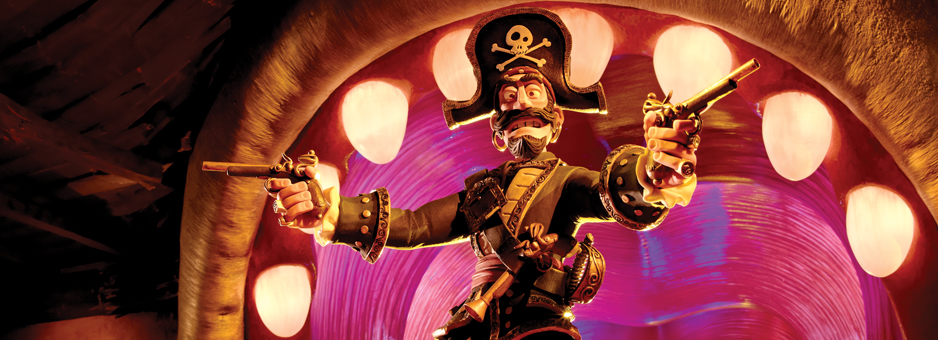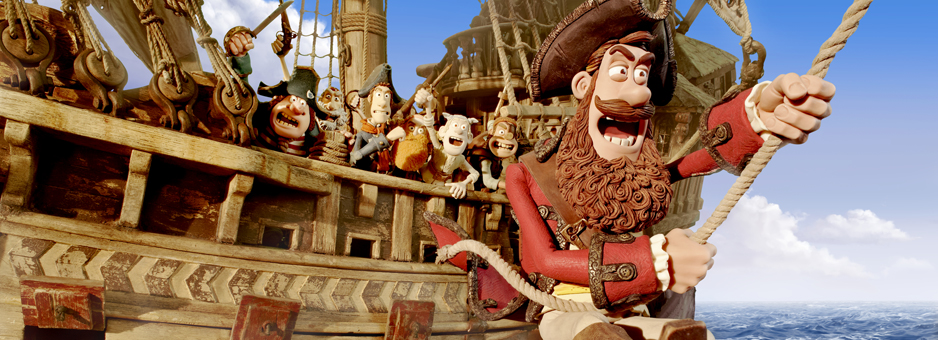- Panzehir
- Double Xposure
- Ram-Leela
- Ilo Ilo
- Elysium
- Welcome to the Punch
- Pacific Rim
- Bad Parents
- Archive




Aardman Sets Sail with FilmLight's Baselight for "The Pirates!"
Academy Award® winning animation studio Aardman (Chicken Run, Wallace and Gromit: Curse of the Were Rabbit) returns to theatres this month with the swashbuckling adventure The Pirates! In an Adventure with Scientists, released internationally in 2D and stereoscopic 3D by Sony Pictures Animation. Based on the popular book series by Gideon Defoe, the film is a gleeful tale of the prodigiously bearded Pirate Captain (Hugh Grant) and his obsessive mission to win the title of "Pirate of the Year."
Directed by Peter Lord and Jeff Newitt, the production of the film took more than two years and required a team of hundreds of animators, editors, visual effects artists, producers and other crew. It also involved a novel use of FilmLight's Baselight colour grading system as a real-time engine for reviewing dailies and for technical checks of shots captured on the sets.
The Pirates! wasn't originally intended to be produced in stereo 3D, but when that decision was taken early in pre-production, it made an already complex production that much more challenging. A 3D production would require 3D camera rigs, and twice the amount of camera data. It also meant that the production crew would be working with depth and would need to be mindful of 3D issues that could cause audience discomfort or require costly post-production fixes.
It quickly became apparent that a system was needed to review shots as they were being produced both to check them for quality from a creative point of view and to identify potential technical issues. An ordinary video review system would not do, as it would be necessary to assemble shots into sequences; compare them with other shots, sequences and alternate takes; apply colour grades and do it all virtually instantaneously.
"We needed a meaty, powerful system that would essentially act as a dailies machine," explains Andy Morley, the film's visual effects supervisor. "We needed a real-time system, a real-time stereo system, and one that could store the whole film at one go, including multiple versions of shots. For some shots that might mean 100 versions."
Aardman reviewed several possible solutions before selecting a Baselight HD system. It chose Baselight for its ability to work with a high volume of high resolution images in real-time, its exceptional stereoscopic toolset and its proven reliability. "For me, it was a no-brainer," says Morley, who had previously worked with Baselight at Framestore while generating shots for Avatar. "I didn't want to mess around with a lower-powered system. I needed a guarantee."
The Baselight HD system was set up in a small room adjacent to Aardman's main screening room. (After Morley had the room's walls painted black, the crew affectionately dubbed it "The Black Hole.") The system was connected to a multitude of monitors—a dual screen True3di stereo monitor, 2 x Eizo graded monitors, and finally a 40 inch LED for review purposes and integrated into the production workflow so that shots could be quickly imported and exported to and from the stage, as well as to and from the editorial and visual effects departments.
Despite the advent of digital cameras, computer controlled-rigs and photo-real CG, stop-frame animation remains very much a hand-crafted art form. Shots are executed one frame at a time with tiny adjustments made to the meticulously crafted puppets and set pieces in between. It is therefore crucial to be able to review shots quickly and in detail as reshoots take a very long time and can be extremely costly. Baselight made it possible to apply grades to shots so that they could be reviewed in a close-to-final form (and in 3D), making it possible to accurately judge colour, lighting, movement and other aspects.
Baselight's ability to store hundreds of shots and recall any one of them instantaneously was crucial in making comparisons, both between different versions of the same shot, and between different shots in a sequence. "In stop frame you might have shots that are next to one another in the timeline, but, for practical reasons, are shot six months apart," explains. Morley. "In normal live action production, it's easy to flip the camera from one actor to another, but in stop frame, it's easier to shoot all the shots from one angle first. So, you might shoot shots 1, 3, 5 and so on in a process that could take months before you go back and shoot the others." In Baselight shots captured out of sequence could be quickly assembled into the correct timeline, graded and reviewed for consistency.
Baselight also made it possible to quickly spot and correct stereoscopic errors. "When shots came off the floor, we would load them into the system and do an immediate technical check," Morley recalls. "If there were vertical alignment errors or other issues, we could adjust the stereo in real-time. If there were problems that required a reshoot, we could show the director and the d.p. then and there, what the problem was so that they could make an adjustment. It worked fantastically well."
Colour management was another important issue. The Pirates! offers a number of extreme and contrasting looks, between, for example, the sunny Caribbean islands where the pirates make their home and the murky, fog-encrusted streets of London. The production used FilmLight's Truelight technology to ensure consistency in colour by applying LUTs to camera data and by managing colour through the visual effects and post-production processes.
As Morley explains, final grading for the film was also going to be done on a Baselight system (at Technicolor) and so, by using Truelight to create LUTs matched to their Baselight, colour accuracy was assured. "A FilmLight engineer set up a Truelight profile, customized to our project, and it became the standard for matching shots throughout production," he says. "If shots were coming off the floor too dark or too saturated, we'd note that in Baselight. If time permitted, production would change the lighting, otherwise the VFX department would make the necessary balancing changes."
Ultimately, the ability to make that type of judgement not only avoided problems and production delays, it helped Aardman make a better movie. "Without Baselight, reviewing work at the sequence level would have been problematic . Getting shot approval from the director and d.p. would also have been much more difficult as there were so many demands on their time," Morley explains. "As it was, they didn't need to go into the screening room to see a sequence; we could show it to them instantly. And if they needed to see version 50 of a shot, we could do that because Baselight kept it all on line. Had we lacked that ability, we would have gotten fewer versions in front of the director, and that would have impacted the quality of the film."
Andy Morley is the owner and VFX Supervisor at Fuzzy Logic FX, a boutique VFX facility, based in London and Bristol (www.fuzzylogicfx.com).



